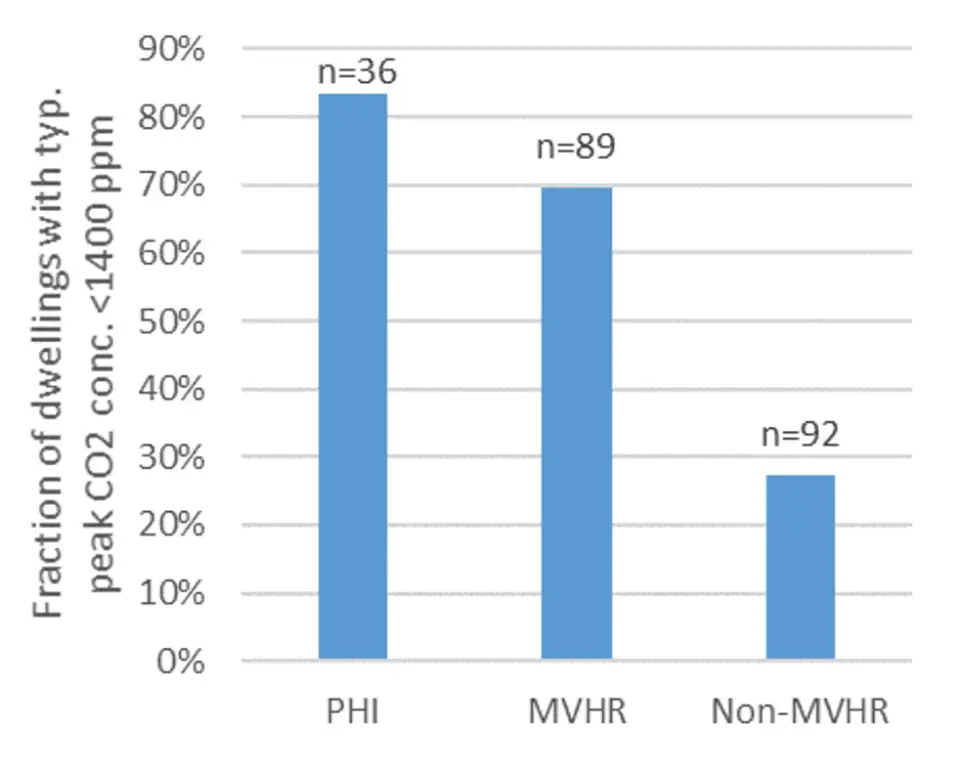With increasing numbers of people spending more and more time indoors, air quality inside buildings is a growing concern. Although often considered primarily a standard designed to ensure high levels of energy efficiency in buildings, the international Passive House standard was developed from the start with comfort and hygiene standards in mind; in other words, good indoor air quality (IAQ) was baked into the standard from the beginning.

But how well does the application of this standard achieve its original goals? A review of the indoor air quality in residential Passive House dwellings, which was conducted by a team headed by Gabriel Rojas from the University of Innsbruck and is currently published in Energy and Buildings, comprehensively addresses this question. A total of 35 studies from around the world, reporting measurements from 648 dwellings that applied the Passive House ventilation approach, were included in this review; the references alone are invaluable. Most of these studies evaluated temperature, relative humidity (RH), and carbon dioxide (CO2) concentrations.
The studies included in this review had to at a minimum report the measurement methods for assessing indoor air pollutants within occupied residential buildings and have reported on CO2 levels for at least three consecutive days. The dwellings included in the studies had to be either certified by PHI, designed to PHI guidelines but not certified, or built to meet another passive house or low-energy standard and were equipped with mechanical ventilation with heat recovery (MVHR).
The compiled data and resulting analyses are extremely helpful, even as the review’s conclusions in many ways are not surprising. “An analysis of the CO2 measurements reveals that in homes which apply the PH ventilation approach, peak concentrations were, on the whole, substantially lower than in conventional homes which only rely upon natural ventilation and/or occupant-controlled window opening and that 74% of those dwellings never measured CO2 concentrations above 1,400 ppm,” the study’s authors concluded. In addition to Rojas, the authors were Martin Fletcher and David Johnston of Leeds Beckett University, and Mark Siddall from the UK-based Lovingly Engineered Architectural Practice. The 16 dwellings that had no MVHR systems and relied mostly on natural ventilation had CO2 measurements that exceeded 1,400 ppm just under 25% of the time.


Fraction of dwellings where measured maximum CO2 concentration was <1400 ppm (and reported dwelling-wise for bedroom or living room).


Average fraction of time where CO2 concentration in bedrooms was >1400 ppm of dwellings where this metric was reported and >0 %. PHI: Passive House certified dwellings only, MVHR: dwellings with Passive House ventilation approach excluding PHI certified dwellings, Non-MVHR: all other dwellings (mostly naturally ventilated).
The authors point out that a prerequisite for achieving good indoor air quality is not only having a MVHR system but having it correctly installed and operating. Pursuing PHI certification greatly improves the odds of correct installation. More than 80% of the PHI-certified dwellings in a UK study were appropriately balanced and met supply-air guidelines, while only 30% of the non-certified Passive House dwellings with MVHR systems met both criteria. Imbalances between supply and extract air flows impact the efficiency of the heat recovery, the energy use of the system, and also potentially increase moisture issues.
As to the question of whether PH ventilation strategies are adequate for removing cooking-related particulates from home, the authors remain somewhat neutral. They acknowledge the paucity of studies reporting on particulate matter exposure in Passive Houses, saying, “Results suggest that the typical PH ventilation approach (MVHR with high grade supply air filtration in combination with a recirculating cooker hood) is likely to effectively reduce particles originating from the ambient environment, but not necessarily from indoor sources like cooking.” However, they go on to point out that, subsequent to these studies, in 2019 PHI released Kitchen Exhaust Systems for Residential Kitchens in Passive Houses. Rojas, the lead author on this review, is well experienced in this topic, as evidenced by his co-authorship of a paper published in 2017, entitled “Evaluating the Performance of Island Kitchen Range Hoods.” Clearly, further research is needed to examine the impact of the design of kitchen ventilation systems on particulate matter exposure while cooking in Passive Houses, and how switching to induction cooktops—an increasingly common choice in new construction—might affect ventilation design choices.


Average air exchange rate in multi-family houses (MFH) and single-family (SFH) / semi-detached (SDH) / terraced houses (TH).
![Fraction of dwellings of selected studies, where measured supply air flow complied with national guidelines. For UK the compliance with total dwelling air flow rate as required in AD:F [52] was evaluated. For Austria compliance with supply air rate requirement for bedrooms as defined in ¨ONORM H 6038:2014 was assessed. PHI: Passive House certified dwellings only, MVHR: dwellings with PH ventilation approach excluding PHI certified dwellings, Natural: all other dwellings where measurement data was available (all naturally ventilated).](
/img/asset/cHVibGljL2ZpZzJyLnBuZw/fig2r.png?w=960&fit=crop&fm=webp&q=60&filt=0&s=6a06375c19907c2a5003d481cc3078ab
)
![Fraction of dwellings of selected studies, where measured supply air flow complied with national guidelines. For UK the compliance with total dwelling air flow rate as required in AD:F [52] was evaluated. For Austria compliance with supply air rate requirement for bedrooms as defined in ¨ONORM H 6038:2014 was assessed. PHI: Passive House certified dwellings only, MVHR: dwellings with PH ventilation approach excluding PHI certified dwellings, Natural: all other dwellings where measurement data was available (all naturally ventilated).](/assets/fig2r.png)
Fraction of dwellings of selected studies, where measured supply air flow complied with national guidelines. For UK the compliance with total dwelling air flow rate as required in AD:F [52] was evaluated. For Austria compliance with supply air rate requirement for bedrooms as defined in ¨ONORM H 6038:2014 was assessed. PHI: Passive House certified dwellings only, MVHR: dwellings with PH ventilation approach excluding PHI certified dwellings, Natural: all other dwellings where measurement data was available (all naturally ventilated).